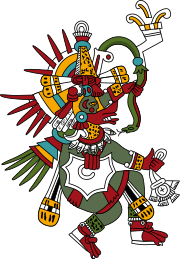Oxomoco
Oxomoco also known as Oxomo[1] is an Aztec deity, the goddess of the night, the astrology and the calendar. Oxomoco and Cipactonal were said to be the first human couple, and the Aztec comparison to Adam and Eve in regard to human creation and evolution.[2][3] They bore a son named Piltzintecuhtli, who married a maiden, daughter of Xochiquetzal.[4] As an older woman she was also known as Itzpapalotl.[3]
Origin of the Name
Dr. Rafael Tena of the INAH translates the name Oxomoco as "First Woman" saying that it is a Huastec word morphed into Nahuatl. Uxumocox; Uxum (Woman) and Ocox (First).
Depictions
Oxomoco and Cipactonal are mentioned in the Aztec Annals of Cuautitlán; they were in charge of the calendar.[5] They also appear in Quiché legends such as within the Popol Vuh.[6] Some scholars, such as the Nicaraguan Fernández de Oviedo y Valdés claim that Cipactonal was actually the female and Oxomoco actually the male and referred to one of them as Tamagastad.[3] Other scholars from the Nicaraguan perspective such as Ephraim George Squier and Frank E. Comparato also claim that Oxomoco was male and Cipactonal female and claim that they were sorcerers and magicians.[6] Nahuatl terms of the four shamans who stayed at Tamoanchan are not gendered with the exception of Oxomoco who was female.[7] In the Codex Borbonicus, Oxomoc, like Cipactonal, usually wears the tobacco gourd of priestson her back.[8] In some depictions the goddess is wearing a butterfly mask and throwing maize and beans from a vessel.[9] In the Florentine Codex, Oxomoco is depicted divining with knotted cords.[7] There is a notable carving of Oxomoco and Cipactonal near Yautepec, Morelos.[8]
References
- ↑ Otilia Meza (1981). Editorial Universo México, ed. El Mundo Mágico de los Dioses del Anáhuac (in Spanish). México. p. 47. ISBN 968-35-0093-5.
- ↑ Austin, Alfredo López (1988). The human body and ideology: concepts of the ancient Nahuas. University of Utah Press. p. 238. ISBN 978-0-87480-260-3. Retrieved 26 October 2011.
- 1 2 3 Austin, Alfredo López (1996). The rabbit on the face of the moon: mythology in the mesoamerican tradition. University of Utah Press. pp. 102–6. ISBN 978-0-87480-527-7. Retrieved 26 October 2011.
- ↑ "Aztec cosmology". University of Texas. Retrieved 26 October 2011.
- ↑ New World Archaeological Foundation (1995). Papers of the New World Archaeological Foundation. New World Archaeological Foundation. p. 227. Retrieved 26 October 2011.
- 1 2 Squier, Ephraim George; Comparato, Frank E. (1990). Observations on the archaeology and ethnology of Nicaragua. Labyrinthos. p. 29. ISBN 978-0-911437-08-9. Retrieved 26 October 2011.
- 1 2 Boone, Elizabeth Hill (2007). Cycles of time and meaning in the Mexican books of fate. University of Texas Press. pp. 24, 25–. ISBN 978-0-292-71263-8. Retrieved 26 October 2011.
- 1 2 Smith, Mary Elizabeth; Boone, Elizabeth Hill (2005). Painted books and indigenous knowledge in Mesoamerica: manuscript studies in honor of Mary Elizabeth Smith. Middle American Research Institute. p. 14. ISBN 978-0-939238-99-6. Retrieved 26 October 2011.
- ↑ Nowotny, Karl Anton; Everett, George A.; Sisson, Edward B. (2005). Tlacuilolli: style and contents of the Mexican pictorial manuscripts with a catalog of the Borgia Group. University of Oklahoma Press. p. 61. ISBN 978-0-8061-3653-0. Retrieved 26 October 2011.
